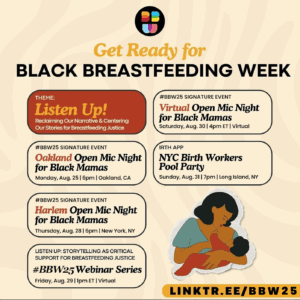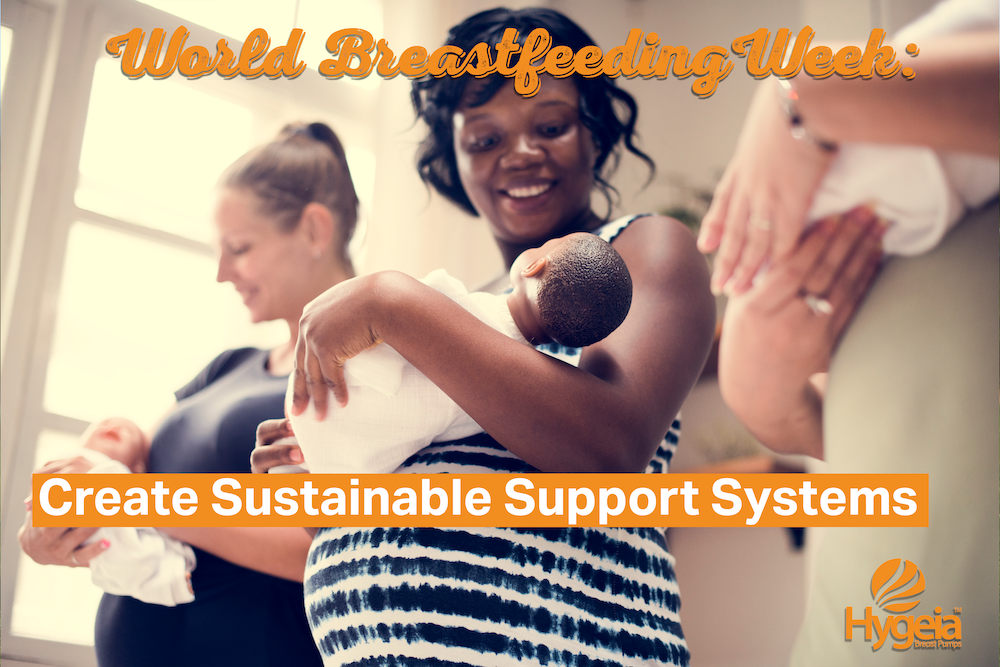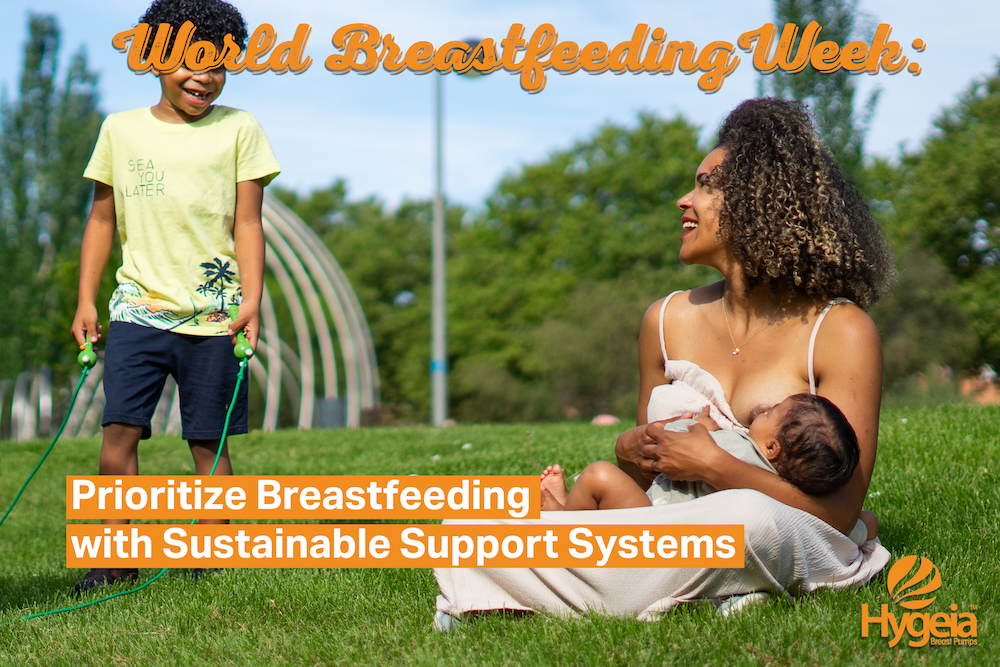
August is National Breastfeeding Month, and this final week, August 25-31, is dedicated to Black Breastfeeding Week (BBW). This week is a crucial part of the national observance. It highlights the unique challenges and triumphs of black mothers on their breastfeeding journeys. This blog post will explore why this week is so important and how you can get involved. The 2025 theme for BBW is Boots on the Ground: Rooted in Breastfeeding Success, Grounded in Community Support.
Why Black Breastfeeding Week Exists
Black Breastfeeding Week began in 2013. It was created to address the significant racial disparities in breastfeeding rates. For decades, Black women have had the lowest breastfeeding rates in the U.S. This is not due to a lack of desire to breastfeed. It is a result of historical and systemic barriers. These barriers include a lack of targeted community support, racial bias in healthcare, and the historical trauma of slavery, which severed cultural connections to breastfeeding.
This week exists to bring awareness to these issues. It celebrates the strength and resilience of the Black community. It provides a platform for education and advocacy. The goal is to build a supportive network that addresses systemic inequalities and promotes health equity for Black families.
What to Expect During Black Breastfeeding Week
Black Breastfeeding Week is a vibrant time of celebration and education. The week is filled with events both online and in local communities. While specific events vary each year, you can typically expect a mix of the following:
Virtual Events: Many organizations host webinars and online conferences. These sessions focus on topics like historical context, finding community support, and overcoming common breastfeeding challenges. Be sure to check out the Virtual Open Mic Night on Saturday, August 30 at 4 p.m. EST.
Community Gatherings: Local organizations often host meet-ups, workshops, and latch-on events. These gatherings provide a safe and encouraging space for new mothers to connect. For those in the Oakland, CA or New York City area, can check out the Oakland or Harlem Open Mic Nights on Aug. 25 and Aug. 28. Search online for events are happenings in your area.
Social Media Campaigns: The Black Breastfeeding effort is strong on social media and you can help spread awareness from wherever you are and whatever you are doing simply by sharing posts and engaging with them. Expect to see powerful stories, art, and information shared widely online. They can be found on Facebook, Twitter and Instagram. Following the official hashtags is another great way to show your support and learn more throughout the campaign. Check out: #BBW25 #BootsOnTheGround #blackbreastfeedingweek
Expert Q&As: Lactation consultants and healthcare professionals often offer live Q&A sessions. These provide valuable, accessible information for mothers. At Hygeia Health we partner with Nest Collaborative to provide virtual breastfeeding consults accessible anytime, anywhere, covered by most insurance plans at no cost to you.
To find a full list of official events, visit the Black Breastfeeding Week website.

Supporting All Moms During National Breastfeeding Month
At Hygeia, we believe every mother deserves full support on her feeding journey. We understand that a high-quality breast pump is a tool that can make a big difference. Our breast pumps are designed for both comfort and efficiency. We are also committed to removing financial barriers for mothers. You can find out if you qualify to receive a Hygeia pump 100% covered by your insurance plan. Find out if you qualify here.
Black Breastfeeding Week reminds us that true support must be inclusive and culturally sensitive. It is an opportunity for all of us to listen, learn, and act. By championing equity in lactation care, we help build a healthier future for all children. Join us in celebrating this important week and supporting every mother’s choice.

World Breastfeeding Week wrapped up last week, but it was immediately followed by the kick off of Indigenous Milk Medicine Week (IMMW). It is observed each August 8-14 as another spotlighted week during National Breastfeeding Month. Indigenous cultures have long recognized the healing properties of breast milk. Indigenous Milk Medicine honors this tradition and emphasizes the importance of cultural sensitivity in breastfeeding support.
Unapologetically Indigenous: Love, Landback, and Liberation
This year’s theme, “Unapologetically Indegenous: Love, Landback, and Liberation,” will affirm Milk Medicine as living knowledge that nourishes sovereignty and love. They aim to celebrate the strength, connection, and healing that Milk Medicine brings through community care. “From our Ancestors to future generations, Milk Medicine is a vital thread that holds us together,” their website states.
- Love is the core of the Indigenous Milk Medicine Collective does as deep kinship is what binds communities and families.
- Landback represents the reclamation of traditions and practices that have sustained the community for generations.
- Liberation stands for the reclamation of the right to practice traditional birthkeeping and lactation.
Each day of IMMW features a theme, complete with “what to wear” and a directive for individuals to participate or show their support online. The week kicked off with a livestream on Aug. 7. You can catch the replay, featuring artist Soni Lopez-Chavez (Chichimeca), on their Facebook page along with Q&A sessions and other featured live streams. The event’s virtual 5K kicked off Aug. 9 and is open to participation through Aug. 14.
Virtual Conference & Featured Artist
On Monday, Aug. 11 the Indigenous Milk Medicine Conference began. The virtual event runs through Aug. 14 and offers a unique opportunity for participants to learn from knowledge sharing educational sessions.. The sessions include topics such as, “Unmasking Neurodiversity in Indigenous Lactation and Early Postpartum”, “First Foods, Fluid Identities: Parenting and Feeding 2-Spirit Futures”, and more. Each day offers valuable sessions with powerful speakers.
Part of IMMW is to feature an Indigenous artist that will uplift and highlight Indigenous talent while bringing to life that year’s theme. The 2025 featured artist is Soni Lopez-Chavez. She is a Chichimeca artist whose powerful work centers Indigenous identity, healing, and liberation.
Supporting All Moms During National Breastfeeding Month
Hygeia Health is committed to supporting all mothers, including Indigenous moms, on their breastfeeding journey. Our breast pumps are designed with comfort and efficiency in mind, but we know that a great pump is just one piece of the puzzle. We believe in providing comprehensive support, including education, resources, and community. Hygeia offers moms an opportunity to receive a high quality pump 100% covered by their insurance. Find out if you qualify here.
Let’s continue to celebrate the power of breast milk in the month of August, and advocate for policies that support Indigenous Milk Medicine families year-round.

The most common word used to describe breastfeeding is “natural”. This act shared between mother and baby reflects the beauty found in the natural role of motherhood. “Natural” also reflects why breastfeeding needs prioritized in today’s world. Breastfeeding is a natural solution and therefore a sustainable one. World Breastfeeding Week 2025 inspires us to look beyond the immediate act of feeding and consider a much bigger picture. This blog post will dive into the this year’s theme: “Prioritize Breastfeeding: Create sustainable support systems.”
The Environmental Toll of Artificial Feeding
Hygeia is in full support of all mother’s and how they choose to feed their babies, be it breastfeeding or formula. Fed is best. No questions. This is truly the most important thing for every baby and that every mom knows what is best for her and her baby.
However, it is important to recognize that the environmental impact of artificial feeding is considerable. The entire process of formula production is energy-intensive and resource-heavy. From sourcing ingredients to manufacturing, packaging, and global distribution, it is a far cry from a “natural renewable food” like breast milk. One one hand, breast milk is environmentally safe and produced and delivered to the consumer without pollution, packaging, or waste. Artificial milk options demand significant amounts of electricity, fuel for transportation, and water for processing and cleaning. The waste generated, from non-recyclable containers to discarded formula, places a heavy burden on our planet’s ecosystems.
Building Sustainable Support Systems
Recognizing breastfeeding’s vital role in a sustainable future isn’t enough. We must create robust and sustainable support systems for families. There are numerous ways this can be done.
- Community Support: Grass roots is where all things begin. Fostering networks of lactation consultants, peer support groups, and family encouragement are necessary for normalizing breastfeeding. At Hygeia, we offer lactation support in partnership with Nest Collaborative. These virtual breastfeeding consults are accessible anytime, anywhere, and covered by most insurance plans.
- Workplace Policies: For breastfeeding to be normalized there must be support in the workplace. This will happen through advocacy for comprehensive paid maternity leave and flexible work arrangements. Additionally, moms need dedicated breastfeeding-friendly environments with clean, private lactation spaces.
- Healthcare System: The support and education must begin from day one for mothers. We must ensure that healthcare providers are well-trained in lactation support. Facilities must also adhere to best practices like the Baby-Friendly Hospital Initiative.
- Policy and Advocacy: Globally, we must endorse policies that protect, promote, and support breastfeeding. This includes strict adherence to the International Code of Marketing of Breast-milk Substitutes to counter misleading marketing.
- Changing the Narrative: All of these steps will play a part, but individuals must also work to normalize breastfeeding in all settings. Encourage a mom who is breastfeeding in public. Educate a friend on her public breastfeeding rights. Help dismantle any lingering stigma around breastfeeding.
Breastfeed
At Hygeia, we believe that empowering mothers is the first step toward a more sustainable future. By providing you with access to our high-quality breast pumps, we aim to make breastfeeding a comfortable and efficient experience. Every journey is unique, which is why we’re dedicated to helping you get your pump 100% covered by your insurance plan. We are removing financial barriers to this natural choice.
Supporting a mother is an act of environmental stewardship. By strengthening the systems around us—from our communities to our workplaces—we can make breastfeeding a realistic option for more families. It’s an investment in a healthier tomorrow, for our children and for our planet. Therefore, join us in championing this natural, sustainable solution during World Breastfeeding Week.

Imagine a single act that nourishes a baby, empowers a mother, and protects our planet. This World Breastfeeding Week 2025, we’re doing more than celebrating infant feeding; we’re championing a powerful solution for our planet’s future. From August 1st to 7th, the #WBW2025 campaign will shine a crucial spotlight on the profound connection between breastfeeding, environment, and climate change, urging all to “Prioritize Breastfeeding: Create Sustainable Support Systems.”
The world is in the trenches of era where environmental concerns dominate global conversations. Hygeia will always support mothers in finding the best solution for their personal situation and seeing to it that baby is fed and mother is healthy. However, at Hygeia, we also know it is vital to recognize breastfeeding as a key player in fostering a sustainable environment and actively reducing the impact of climate change caused by artificial feeding.
The Green Power of Breastfeeding
Breast milk is often called nature’s perfect food, but its environmental benefits are equally remarkable.
Reduced Carbon Footprint
Unlike infant formula, breastfeeding boasts a significantly lower carbon footprint. It requires no industrial manufacturing processes, factories, or energy-intensive machinery that release greenhouse gas emissions. Furthermore, breast milk is the ultimate local food; it requires no transportation, eliminating the emissions associated with shipping ingredients or finished products across vast distances.
Waste Reduction
Breastfeeding is a champion of waste reduction. It produces absolutely zero waste – no plastic bottles, no metal cans, no paper packaging to end up in landfills. Breastfeeding also significantly reduces water consumption. There’s no need for water to prepare formula or sterilize bottles, conserving this precious resource. While a breastfeeding mother needs to stay hydrated, this is a natural biological need, not an industrial demand.
Conservation of Resources
Breastfeeding lessens our reliance on industrial agriculture, particularly the dairy industry. Most formulas are cow’s milk-based, an industry known for its contribution to methane emissions from livestock, extensive land degradation for grazing, and massive water usage. By choosing breastfeeding, we indirectly support resource conservation and the protection of biodiversity, promoting more sustainable practices overall.
Championing the Natural Solution
This World Breastfeeding Week 2025, let’s come together to champion this incredible, natural solution. At Hygeia Health, we are dedicated to empowering mothers through high-quality breast pumps and comprehensive support. Our products are designed to make breastfeeding more comfortable and efficient, while our resources provide valuable information and guidance.
By prioritizing breastfeeding and building strong, lasting support systems, we’re not just investing in the health and well-being of our children; we’re taking meaningful climate action and fostering a truly sustainable environment for future generations. Every ounce of breast milk is a drop in the ocean of positive change.

Breastfeeding in public is a powerful and natural act–let’s get that fact out in the open from the start. It allows you to nourish your baby whenever and wherever they need it. Because of this, no mom should ever feel that other people’s comfort should trump their baby’s need to eat. However, it’s also important to not judge each other as breastfeeding mothers. While you may not think twice about breastfeeding in a crowded restaurant, a first-time mom who is the first of her friends or family to breastfeed may not share your confidence
That confidence often comes with practice and early in the journey having the right tools can make a big difference. This blog covers the products meant to help create comfort, discretion, and convenience, empowering any mom to breastfeed anywhere.
Essential Apparel for Public Nursing
Choosing the right clothing can simplify public breastfeeding immensely.
Nursing Bras: A good nursing bra offers easy, one-handed access. Look for options with simple clasps or pull-aside designs. They provide necessary support while making feeding quick and discreet. Many brands offer comfortable, wire-free styles perfect for everyday wear.
What to choose? Check out this list of best nursing bras in 2025 from BabyList.
Nursing Tops: These tops feature hidden openings, lift-up panels, or crossover designs. They allow you to nurse without exposing your midsection or needing to lift your entire shirt. Pairing a nursing top with a cardigan or jacket can add another layer of discretion.
What to choose? Here’s a list of 30 of the best nursing tops in 2025 from MomLovesBest.
Layered Clothing: This simple strategy is often the most effective. Wear a loose top over a tank top. When it’s time to feed, lift the outer shirt and pull down the tank top. This creates a natural cover around your midsection while keeping you comfortable.
What to choose? Try these nursing tanks recommended by Mom Junction.
Covers and Privacy Tools
While not every mom chooses to use one, nursing covers can offer extra privacy. Some baby’s even come to prefer the cover!
Traditional Nursing Covers: These are often apron-style or poncho-style fabrics that drape over you and your baby. They come in various patterns and materials. Some have a rigid neckline that allows you to maintain eye contact with your baby.
Check it out: The Kids N’ Such Nursing Cover with a built in burp cloth.
Multi-Use Covers: Many popular covers double as car seat covers, shopping cart covers, or even scarves. This versatility makes them a smart investment for busy moms. They are lightweight and easy to pack.
Check it out: These top picks are extremely versatile and well loved.
Light Blankets or Swaddles: A simple, lightweight blanket or muslin swaddle can serve as an impromptu nursing cover. They are breathable and typically something you already carry for your baby.
Check it out: The Aden+Anais Muslin Swaddle Blankets are a long-time favorite.
Beyond the Products: Confidence and Rights
Remember, you have the legal right to breastfeed in public in all 50 U.S. states. The best product for public breastfeeding is often your own confidence. The tools listed in this blog simply offer practical ways to feel more comfortable and empowered as you nourish your baby, no matter where you are.
Use this guide to be well versed in your state’s public breastfeeding laws and how your rights are protected.
Pumping in Public
You also have every right to pump in public. The Hygeia Express is dependable for quick, quiet pumping when you need to relieve engorgement or express any amount of milk. With it’s collection cups the Hygeia Express even functions as a hands-free pump. By fitting inside your bra, it allows for completely hands-free and discreet milk expression. Weighing less than a pound, it is ideal for multitasking or pumping on the go without drawing attention due to it’s whisper quiet technology.
At Hygeia Health, we champion every breastfeeding mom. We understand the importance of reliable tools that integrate into your active life. We believe access to a quality pump is a right, not a privilege. Did you know that many insurance plans cover the cost of a breast pump? Hygeia Health specializes in helping moms navigate this process to get a 100% insurance-covered breast pump.
Ready to enhance your breastfeeding confidence with a high-quality pump designed for your active life? Apply today to see if you qualify for a free Hygeia Health breast pump.






